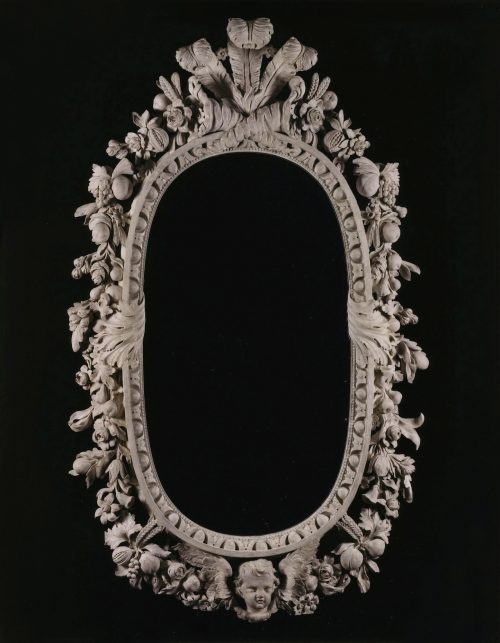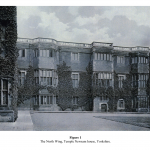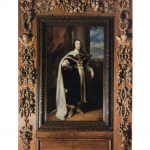8022 A FINE CARVED AND PAINTED MIRROR FROM THE STATE BEDROOM, TEMPLE NEWSAM HOUSE English. Circa 1720. Measurements: Height: 74 3/4″ (190cm) Width: 45 1/4″ (115cm) Depth: 8″ (20cm)

Research
Of carved and painted deal. The old but later oval plate within a bold egg and dart frame tied on each side with acanthus clasps and surmounted by a large three-feathered plume resting on crossed cornucopiae, the whole frame garlanded with trailing fruit and foliage and terminating in a winged putto mask. Traces of gilding beneath white painted decoration.
Provenance:
Temple Newsam House, Yorkshire.
Recorded in the State Bedroom at Temple Newsam in the inventory of 1902,
Sold as Lot 403 in the sale of the contents of Temple Newsam House, 1922,
And thence by descent to the previous owner.
Illustrated:
Adam Bowett, Early Georgian Furniture 1715-1740, 2009; p. 299, pl. 6:65.
This magnificent mirror previously formed part of the decoration of the State Bedroom at Temple Newsam house in Yorkshire.
It is mentioned in the surviving inventories of the house of 1902 as being in the State Bedroom: “Large oval mirror in a carved wood frame”. It is later recorded in the sale of Temple Newsam House contents, Leeds in 1922, lot 403, again in the same room as” An upright mirror of oval form, in white paineted frame, boldly carved with lip and tounge moulding, fruit, flowers, and chrub’s head, with surmount of Prince of Wales Feathers”. At the sale it was acquired by Lady Mary Meynell.
Temple Newsam is regarded as one of the most celebrated historic houses in England due, in part, to the survival of the early seventeenth-century building, but also to the magnificent collection of furniture belonging to Leeds City Art Galleries which is now housed there. The existing facade of the house (figure 1) was rebuilt in 1630 by Sir Arthur Ingram, in whose family the house remained until it was sold with many of its contents in 1922.
The relationship of the mirror to the decorative schemes which would have graced the house in the early eighteenth century is apparent from its similarities with the carving to the chimney piece which still stands in one of the bedrooms, with its floral swags and putto mask (figure 2).
The boldly carved frame of the mirror contains elements of both the Baroque and Palladian styles and as such represents a transition between the two. The overflowing cornucopia, the fruit and foliate garlands which surround the frame, and the winged putto mask below the mirror plate are characteristic of the Baroque carving of English craftsmen such as Grinling Gibbons (1648-1721). Gibbons is credited with creating this stylistic vocabulary which dominated the decoration of English country houses in the late seventeenth and early eighteenth centuries.
The similarities between his style and the present mirror are apparent when comparing the mirror frame with the carved overmantel surround in the Privy Chamber at Hampton Court (1699, figure 3). Here Gibbons uses winged putti masks and cascading floral and fruit swags to those which characterise the Temple Newsam Mirror frame.
However, this particular mirror also demonstrates the rising influence of the Palladian style of classicism in England in the first three decades of the eighteenth century. Based on a fascination with the work of the Italian architect Andrea Palladio amongst a select group of English cognoscenti, such as Lord Burlington and the architect William Kent, Palladianism employed a range of classical forms to achieve a lavish yet restrained decorative effect. The bold egg and dart molding which frames the oval mirror plate in this instance is a classic Palladian conceit, often to be found on door frames and chimney pieces of the period, while the acanthine clasps flanking the mirror plate also evoke the classical Palladian style.
The carving is replete with imagery imbued with classical meaning, such as the cornucopiae representing wealth and abundance at the top, Pomegranates, the ‘forbidden fruit’ often associated with Persephone, as well as grapes, the fruit of Dionysus / Bacchus.




Comments are closed.